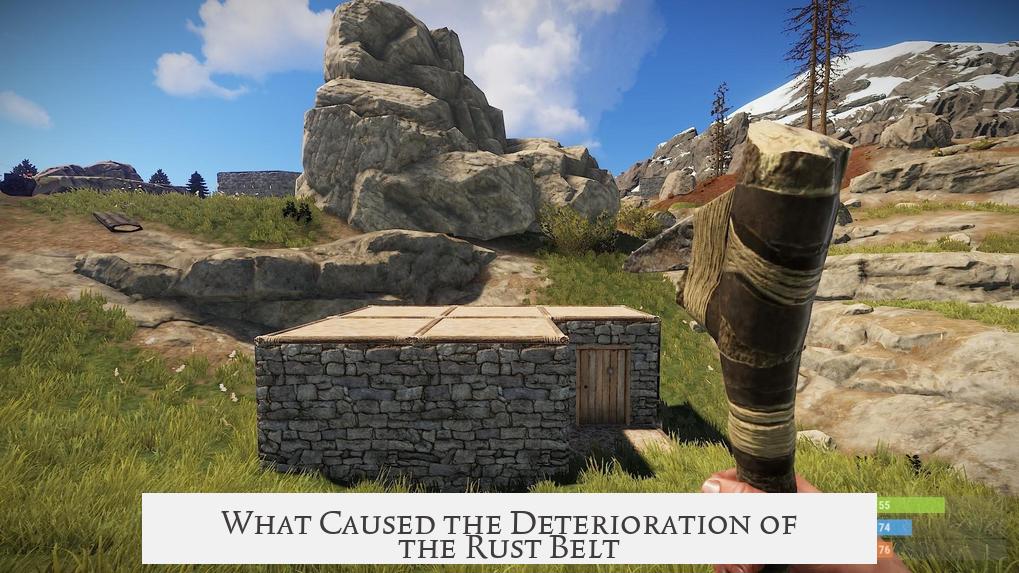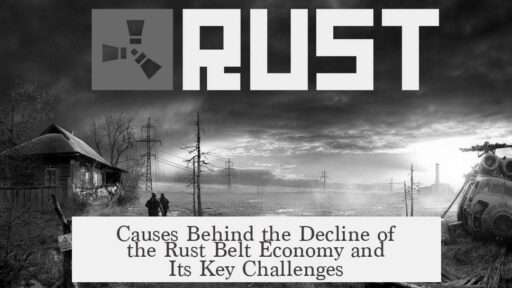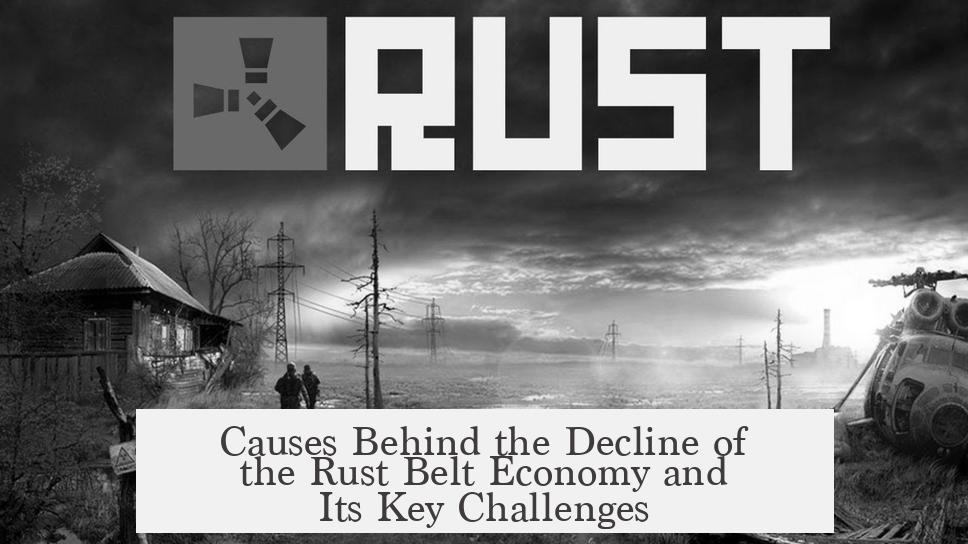The deterioration of the Rust Belt results from a combination of intense foreign competition, technological stagnation in American industries, strained labor relations, and broader economic shifts. These factors converged in the mid to late 20th century to transform once-thriving industrial areas into regions facing economic decline.
The rise of Japanese steelmakers exemplifies the foreign competition American industries struggled against. In 1960, both Japanese and American steel companies required over 20 worker hours to produce 1 metric ton of steel. By 1970, Japanese producers had halved this labor to 7.5 hours, while American firms only managed to reduce it to 15 hours. This improvement stemmed largely from strong state support. Japan’s Ministry of International Trade and Industry designated steel as a strategic sector in 1952. Steel companies benefited from tax exemptions, low-interest loans, cheap or free land, and infrastructure improvements like specialized harbors. These policies encouraged rapid, radical modernization, including tearing down and rebuilding plants with each technological advance. Moreover, Japanese regulators controlled production to prevent excessive competition within the industry. This holistic approach ensured continuous efficiency gains and global competitiveness.
In contrast, American steelmakers faced challenges inhibiting modernization. Labor unions secured high wages—by 1982, Bethlehem Steel workers earned $26.12 per hour, nearly double the average U.S. manufacturing wage and much higher than foreign competitors. Unions negotiated automatic annual wage increases and cost-of-living adjustments. They also employed grievance policies allowing workers to be paid for hours not worked, contributing to inefficiency. Seniority clauses ensured excessive labor retention despite technological changes making some roles redundant.
Management at Bethlehem Steel additionally hindered innovation. Executives often rejected proposed technological improvements and abandoned new methods like continuous casting, citing plant incompatibilities. Corporate spending on non-essential luxuries further drained resources. The U.S. government attempted to shield the industry from imports but did not fund necessary modernization. This lack of government backing, combined with internal inefficiencies and labor costs, positioned American steel producers at a severe disadvantage versus their foreign rivals. Ultimately, many plants closed, accelerating the region’s industrial decline.
Labor relations also shaped the Rust Belt’s fate. Following the Great Depression, the National Industrial Recovery Act established the National Labor Relations Board, mandating collective bargaining between management and unions. Over decades, this created a “high-wage equilibrium” where labor demands consistently raised costs, management acquiesced quickly, and shareholders held little power to stop increasing expenses. This cycle hurt profits and is often blamed for the industry’s woes. However, unions were only part of the problem. Government regulations and management decisions contributed as much to the challenges faced. The destructive wage and working conditions cycle was secondary to global competition and innovation deficits.
Broader macroeconomic factors further compounded difficulties. Manufacturing requires huge capital investments, making it sensitive to interest rates. The 1970s and early 1980s saw stagflation, oil price shocks, and stock market downturns, driving interest rates high and dampening industrial profitability. These economic pressures disproportionately affected capital-intensive industries like steel and auto manufacturing.
The Rust Belt also suffered from structural and societal shifts. The decline in steel demand as automakers adopted lighter materials, motivated by fuel efficiency standards, reduced steel consumption. The completion of major interstate highway projects in the 1970s decreased the need for large-scale bridge construction, further depressing steel demand.
Population loss in Rust Belt cities led to shrinking tax bases and fiscal crises in local governments. This municipal decay was not directly caused by the disappearance of manufacturing jobs but by people leaving cities, straining public services and finances.
| Key Factors | Description |
|---|---|
| Foreign Competition & Technological Innovation | Japanese steel benefited from state support for modernization; U.S. firms stagnated due to lack of investment and rigid labor relations. |
| Labor Relations and Collective Bargaining | High union wages, grievance systems, and seniority clauses increased costs and inefficiencies but were only one part of the problem. |
| Macroeconomic Environment | Stagflation, high interest rates, and oil shocks hurt capital-intensive manufacturing sectors during 1970s-80s. |
| Structural Changes | Decreased steel demand due to fuel efficiency and infrastructure completion; population loss caused local government strains. |
Key Takeaways:
- Japan’s steel industry outpaced U.S. firms via strong state intervention and technological renewal.
- American steelmakers suffered from outdated plants, high labor costs, union-driven inefficiencies, and weak government support.
- Labor unions influenced wages and work rules, but poor management and policy decisions played larger roles.
- Economic shocks and interest rate rises further depressed manufacturing profitability.
- Shifts in demand and urban population declines contributed to the Rust Belt’s economic deterioration.
What Caused the Deterioration of the Rust Belt?

The deterioration of the Rust Belt is primarily caused by the failure of U.S. manufacturing—especially steel—to modernize and compete with foreign industries that enjoyed government support, combined with challenging labor relations and broader economic shifts. But hey, that’s just the elevator pitch. Buckle up for a detailed ride through the smokestacks and boardrooms that shaped this story.
Imagine two steel industries racing side by side in the 1960s: one in the U.S., the other in Japan. Both started off requiring about 20 worker hours to create a metric ton of steel. Fast-forward a decade, and Japanese steelmakers sliced their labor down to 7.5 hours. Meanwhile, American steelmakers barely budged, clocking in at 15 hours. And that gap? It wasn’t just a statistic. It was a ticking time bomb for American steel.
Government Support: The Japanese Secret Sauce
The Japanese government effectively ran a VIP concierge service for its steel industry. In 1952, steel became a “strategic sector,” getting tax exemptions on domestic sales, imports, and exports. The Ministry of International Trade and Industry (MITI) handed out low-interest loans like candy, provided cheap or even free land, and even dredged harbors. This meant factories popped up right on the docks, cutting transport costs to nearly zero.
Then came the business law tweaks. Japan tamed shareholder influence and cleverly capped production to prevent cutthroat competition inside its borders. Pretty neat, right? Plus, Japanese steel companies did what any savvy builder would do—they demolished and rebuilt plants with every tech upgrade, optimizing layouts relentlessly. The long game was victory.
Contrast that with the U.S., where steelmakers took a “rounding out” approach. They tweaked and patched instead of reinventing, chasing short-term profits but dooming themselves to tech stagnation. Meanwhile, government attempts to shield the industry focused more on restricting imports than throwing financial lifelines to total modernization. The result? Overseas competition gained a monstrous edge.
The Fallout at Bethlehem Steel: A Microcosm of a Macro Mess
Take Bethlehem Steel Company (BSC) as a poster child for Rust Belt troubles. By 1982, their workers earned $26.12 per hour, making them the gold medalists of high wage-paying within manufacturing, far outperforming foreign steelworkers’ salaries.
- Unions secured automatic wage hikes and cost-of-living bump-ups. Nice for the workers, but not for the bottom line.
- Grievances? Petty but frequent. Managers found it simpler to pay workers for time lost rather than resolve work issues efficiently.
- Clause 2B? Featherbedding in the form of job security even when automation made roles pointless.
- Executives? Living large with fancy headquarters, golf courses, and lavish spending—no penny-pinching here.
- Innovation? Practically on vacation. Promising tech like continuous casting got shelved when plants couldn’t fit the new gear or executives simply weren’t interested.
This added up to a dinosaur slowly sinking in quicksand—unions, management bloat, and lack of tech enhancement converged to make American steel uncompetitive.
Labor Relations: The Great Exception in Steel
The post-Great Depression U.S. government passed the National Industrial Recovery Act, birthing the National Labor Relations Board (NLRB). This forced management into collective bargaining that helped workers for decades. This cage match created what some called “the Great Exception”—a high wage equilibrium locked in by cyclical labor demands and management acquiescence while shareholders threw in the towel.
Bitter steel execs blamed unions for steel’s troubles. But unions accounted for just a third of this cycle; NLRB policies and managerial decisions formed the rest. So, while labor relations played a role, it wasn’t the main villain here.
The Macro Scene: Oil, Interest Rates, and Economic Turbulence

Rust Belt industries, heavy on capital investment, took a big hit when interest rates spiked from 1973 to 1983. This era, known as stagflation, saw oil prices quadruple and the stock market crumble. Capital became as pricey as a New York penthouse. Manufacturing profits cratered. Plants closed. Hiring froze.
Yet here’s a twist: American manufacturing didn’t truly die. It shrank relative to the entire U.S. economy but actually grew in absolute terms over recent decades, outpacing many other sectors. So, the problem wasn’t the death of industry; it was cities losing people. When factories left, workers often moved away, eroding local tax bases and wrecking municipal budgets.
Declining Demand: Society Turns Its Back on Steel
Changing consumer preferences didn’t help. Cars chasing better fuel efficiency ditched heavy steel for aluminum and plastics. Interstate highway building—a major steel customer—finished mostly by the 1970s. Fewer giant bridges were built. Less steel needed.
It’s like inviting steel to a party where everyone suddenly prefers gluten-free snacks. Ouch.
So, What’s the Big Picture?
- Lack of U.S. government support: In a global arena, foreign steelmakers got state-backed loans, land, and legal tweaks. The U.S. government mostly offered trade barriers but refused to fund modernization.
- Union and labor woes: While high wages, featherbedding, and grievances burdened companies, they were part of a bigger puzzle, not the full story.
- Management megastyle but missteps: Lavish exec lifestyles and resistance to innovation at companies like Bethlehem Steel created inefficiencies.
- Macroeconomic turbulence: High interest rates and stagflation hit capital-heavy industries hard during the 70s and 80s.
- Changing market demands: Fuel efficiency and infrastructure slowdowns reduced need for traditional steel.
- Urban decay from population decline: Manufacturing jobs remained but cities lost their workers and, crucially, their thriving tax bases.
In essence, the Rust Belt’s decline wasn’t a single monster but a cocktail of hard truths served cold. Without government support matching Tokyo’s, American steel had no shot—even if labor and management had played nice.
What Now? Lessons and Recommendations
Can the story of the Rust Belt teach today’s economy anything? Absolutely.
- Invest in innovation, or fall behind: Rebuilding from the ground up like Japan did with every tech wave beats patchwork fixes every time.
- Avoid complacent management culture: Executive opulence doesn’t fuel factories, but smart, forward-thinking leadership does.
- Balance labor relations wisely: Fair wages matter, but productivity and flexibility also deserve the spotlight.
- Support industries strategically: Government backing in key sectors can level the playing field with international competition.
- Adapt to market demands: Diversify and innovate materials and production to keep up with changing consumer priorities.
- Revitalize urban centers: Strengthening local economies can maintain tax bases, sustaining public services and schools.
Understanding what caused the Rust Belt’s deterioration helps policymakers, businesses, and communities keep from repeating history’s harsh lessons. Because who wants another industry ghost town, right?
So the next time you hear a nostalgic lament for the “good old days” of American manufacturing, remember it’s a story written in efficiency gaps, government choices, labor dynamics, and shifting markets. It’s complicated, much like trying to untangle a knotted ball of steel wire—which, frankly, is just how this region’s history plays out.
Primary sources: Chalmers Johnson’s MITI and the Japanese Boom, Jefferson Cowie’s The Great Exception, MB Liberman’s comparative productivity studies, John Hoerr’s And the Wolf Finally Came, and John Strohmeyer’s Crisis in Bethlehem.




